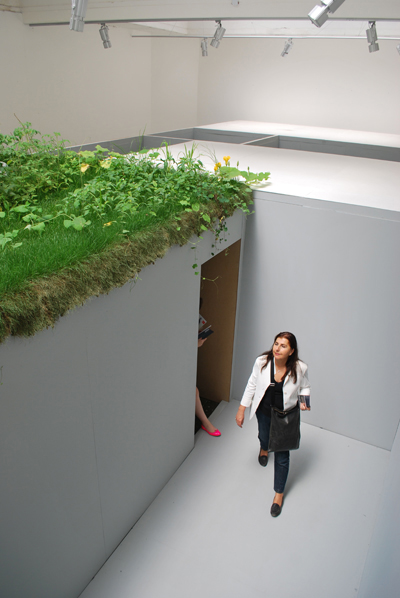| Sun | Mon | Tue | Wed | Thu | Fri | Sat |
|---|---|---|---|---|---|---|
| 1 | 2 | 3 | 4 | 5 | ||
| 6 | 7 | 8 | 9 | 10 | 11 | 12 |
| 13 | 14 | 15 | 16 | 17 | 18 | 19 |
| 20 | 21 | 22 | 23 | 24 | 25 | 26 |
| 27 | 28 | 29 | 30 | 31 |
CATEGORIES
RECENT ENTRIES
BLOG ROLL
Romanian revelations
In the Renaissance Society’s “Seductiveness of the Interval,” Romanian artists explore life after communism and Ceausescu.
As theatrical as its name, the Renaissance Society’s “Seductiveness of the Interval” exhibit, running through June 27, features three Romanian artists who lived under the oppressive reign of former president Nicolae Ceausescu. Curated by art historian Alina Şerban and first shown in the Romanian Pavilion of the 2009 Venice Biennale, the showcase includes works installed in an architectural structure akin to a stage set, complete with stairs and two levels. As viewers move from room to room, they become part of the performance, traveling though the narrow corridors, or, per the title, "intervals," that connect the spaces. Less about communism and Ceausescu than about life in their aftermath, the exhibit explores themes of anger, confusion, growth, and moral progress.
 “Seductiveness” starts on a dark note with Ştefan Constantinescu’s fictional film Troleibuzul 92. In the piece a 20-something man boards a bus and sits next to an older woman with a chin-length bob. After a few moments, he pulls out a cell phone and makes repeated calls to his wife or girlfriend, unleashing a threatening tirade each time: “Tell me—who were you talking to? I’m getting off now to take a cab. I’ll be there in ten minutes. I’ll thrash you ‘til you tell, drench you in blood, I will.”
“Seductiveness” starts on a dark note with Ştefan Constantinescu’s fictional film Troleibuzul 92. In the piece a 20-something man boards a bus and sits next to an older woman with a chin-length bob. After a few moments, he pulls out a cell phone and makes repeated calls to his wife or girlfriend, unleashing a threatening tirade each time: “Tell me—who were you talking to? I’m getting off now to take a cab. I’ll be there in ten minutes. I’ll thrash you ‘til you tell, drench you in blood, I will.”
The woman next to him sits in silence, staring straight ahead. Then the film goes black, prompting the viewer into the next room where Ciprian Mureşan’s Auto-da-Fé awaits. A projector flashes images of graffiti marring urban landscapes throughout Europe: “I am a man of character, that I confess to you” scrawled on a toilet; “were I a traitor” on a slab of concrete; “by your illustrious forefathers” on an old car.
In an adjacent room lies a large water cistern attached to several hoses. “Open your minds, open your hearts, open your souls,” chants an audio recording. The irrigation system and audio are the first glimpse of EXUBERANTIA suspended, Andrea Faciu’s mixed-media installation. At the end of the dark exhibit room, the viewer climbs up a flight of stairs, into the light, and sees the second part: a green, leafy garden perched atop the stage set.
During a May 2 artists' discussion in Kent Hall, Constantinescu said that Troleibuzul 92, based on a scene witnessed while riding a trolleybus, taps into a common Romanian phenomenon: being unable to vent in the workplace and thus releasing frustration in one’s private life, invading the public space of others in the process. Mureşan's Auto-da-Fé, on the other hand, focuses on de- and re-construction of narrative rather than a particular sociopolitical issue. Within its new context—the artist had his friends post graffiti derived from an Elias Canetti novel—each phrase holds new meaning, he explained.
Finally, Faciu told the audience that EXUBERANTIA suspended is a reaction to the lack of order and overwhelming economic and cultural growth that Romanians have experienced. “The entire composition reflects, at a certain level, my own comprehension of the society I grew up in, a society whose many faces are in uninterrupted flux," she elaborates in the exhibition catalog. "I liked the idea of being constricted, searching for a way out, confronting the option of a revelation.”
Katherine Muhlenkamp
May 19, 2010
